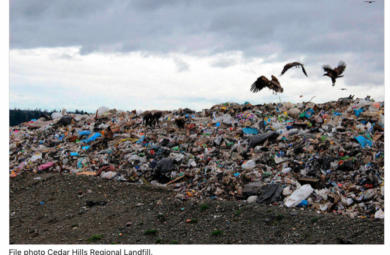On Wednesday evening, April 27th 2022, the King County Solid Waste Division (SWD) held a virtual meeting to provide an update on the expansion and operation of the Cedar Hills landfill, an exercise that can best be described as attempting to put lipstick on a pig. The landfill, originally slated to close decades ago, has been given another 7-10 years via some “sleight of hand” design, but as SWD Director Pat McLaughlin said in response to a question, no alternatives for now or in the future are being considered. The main thrust of SWD’s approach (also stated by Mr. McLaughlin during the meeting) is to “reduce the 70% of what’s being thrown away that could be recycled,” something the agency has been unable to do for the past ten years, by their own admission. On the whole, the SWD’s efforts over the past ten years have amounted to running in place while falling behind. Failure to plan, after all, is planning to fail.

…
Advocates of sustainable energy and waste management have been critical of the King County Solid Waste Division’s apparent push to expand the landfill. In September 2021, the Institute for Energy and Resource Management issued a public statement calling the King County Solid Waste Division’s environmental impact statement a “boondoogle,” and accusing the county of “going through the motions but having the conclusion decided well before hand.”
President of the Institute for Energy and Resource Management, Philipp Schmidt-Pathmann, has been increasingly vocal in his criticism of the King County Solid Waste Division and what he believes has been a lack of investment in recycling infrastructure and systems improvements. He cited stagnate rates of recycling in the region over the years.
Schmidt-Pathmann also has expressed his disbelief in the county’s studies, which claim the possibility of high rates of methane recapture from the landfill. Schmidt-Pathmann believes that the county has overinflated the rates of methane that can be captured as a way of making a landfill look like a more viable and sustainable waste management method than he believes it truly is.
He expressed his skepticism regarding the county’s reported rates of methane capture in a letter to the director of the King County Solid Waste Division in November of 2021.
…

….
Advocates of sustainable energy and waste management have been critical of the King County Solid Waste Division’s apparent push to expand the landfill. In September 2021, the Institute for Energy and Resource Management issued a public statement calling the King County Solid Waste Division’s environmental impact statement a “boondoogle,” and accusing the county of “going through the motions but having the conclusion decided well before hand.”
President of the Institute for Energy and Resource Management, Philipp Schmidt-Pathmann, has been increasingly vocal in his criticism of the King County Solid Waste Division and what he believes has been a lack of investment in recycling infrastructure and systems improvements. He cited stagnate rates of recycling in the region over the years.
Schmidt-Pathmann also has expressed his disbelief in the county’s studies, which claim the possibility of high rates of methane recapture from the landfill. Schmidt-Pathmann believes that the county has overinflated the rates of methane that can be captured as a way of making a landfill look like a more viable and sustainable waste management method than he believes it truly is.
…
I believe that we, as a nation, have an opportunity to change the direction of our policies that determine how we handle our MSW. Currently, we employ a landfill-based infrastructure to dispose of the waste that remains after we compost and recycle. We bury reactive waste in landfills located all over the country. The reactive waste rots and produces methane gas, thus these landfills are a MAJOR source for methane emissions. Recent studies by the EPA and the Environmental Integrity Project (EIP) show the extent of the problem (https://environmentalintegrity.org/reports/greenhouse-gas-emissions-from-marylands-landfills/). The levels of methane emissions have been under-reported for decades. There is a movement towards capturing the methane gas being released from the landfills, but the estimates for successfully capturing the gas are approximately 45-50%.
As someone who has championed the fight against global warming and supported the Green New Deal, you know that we don’t have much time left to prevent a climate catastrophe. The report recently released by the IPCC stated it bluntly: “To avoid mounting loss of life, biodiversity and infrastructure, ambitious, accelerated action is required to adapt to climate change, at the same time as making rapid, deep cuts in greenhouse gas emissions.” There is no question now that we have been too slow, and too cautious, in our collective efforts.
The USEPA has made methane, a potent greenhouse gas at least 25 times more harmful than carbon dioxide, a target of opportunity and necessity, and identified three sectors as the major contributors of methane in the US: energy (chiefly leaking natural gas pipelines), agriculture, and waste management (chiefly methane from landfills, even those with landfill gas capture systems). The EPA has also stated recently that estimates of methane from landfills have been understated by a factor of two. That alone would make landfills a good target for reducing greenhouse gasses. There are many other reasons, however, why moving away from landfilling to an integrated waste management system makes sense, from a financial as well as an environmental perspective. The effectiveness of this approach has been well documented in several European countries, including Denmark, Sweden, Germany, Austria and Switzerland, and would likely be equally successful here.
